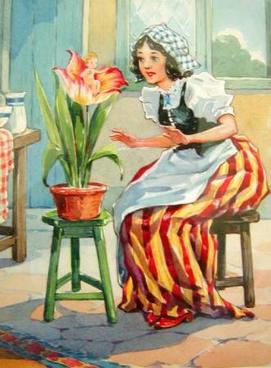|
Katanya is a Jewish tale from Turkey, collected in the Israel Folklore Archives and later published in English in a couple of books. It also recently inspired a music composition. Although the story is sweet, it doesn't have much of substance. It is Thumbelina if you subtracted out the entire plot and skipped directly from Thumbelina's birth to her meeting the prince. I'm not a huge fan of what Thumbelina's plot is, but it exists. The Thumbelina story is an episodic one, featuring multiple bridal kidnappings. The main character has little agency, and is used and judged by one group after another. Her mother and the mysterious fairy are non-entities who disappear quickly from the story. All the other women are negative forces. The female toad and mouse force her into marriage with kidnapping and physical threats (the mouse threatens to bite Thumbelina), and the female beetles brutally mock her appearance and reduce her to tears. The plot of Katanya is basically "Old woman is sad because she has no children. Old woman gets everything she wants." And it's adorable and has positive depictions of women, but it's not particularly exciting. Katanya starts out with the Prophet Elijah showing up to give some dates to a lonely, childless, old woman, and I have to stop here because the fact that it's Elijah is AWESOME. According to the notes, Elijah and King Solomon are the two most popular stock figures in Jewish folktales, and Elijah stories frequently feature him being sent by God to help people in need. Katanya means "God's Little One" and sounds familiar because of another tiny character - K'tonton, whose name means "very little," first appearing in 1930 in short stories and books by Sadie Rose Weilerstein. Like Thumbelina, Katanya is closely associated with sunlight. Thumbelina is born from a flower, loves the sunlight, and goes to live in a summery land of flowers. Katanya is born from a date after it sits in the sun for a while, and she is dressed in shining clothes the color of a rainbow.
Her story is very domestic, dwelling on food and chores such as cleaning the house and sewing dresses. It's a short story and the greater part of it is simply her and her mother doing things together. Katanya's two most memorable traits are her industriousness (one of the first things she does is make a broom for herself out of straw) and her singing, which brings joy to everyone who hears it. She is the model of a good daughter. The beautiful singing voice is a trait she shares with Thumbelina; their voices attract their mates to them. Katanya's prince apparently doesn't care how small his wife is. As in Three-Inch, the tiny hero doesn't need to change. Unlike Three-Inch, Katanya's small size is barely even brought up as a possible problem and the prince mentions it only in passing. Contrast Thumbelina. The fairies are the closest to her "own" kind that she ever finds, but she must still go through a transformation to be with her husband, receiving wings and a new name. Thumbelina goes away from her mother and likely never sees her again. A swallow carries her to a far-off country to meet her prince. Katanya is never separated from her mother, who is, in fact, the one who carries her to the prince. Her mother implicitly blesses their marriage and lives with them in the palace. She has gone from being poor and alone to having a child who is now an adult and can care for her in her old age. Notably, neither heroine has any kind of father figure. Katanya's mother is a widow. For all its flaws, Thumbelina has a more dynamic plot and is more interesting as a story. Katanya's narrative is less dramatic and puts no obstacles in the main characters' paths. It's about a woman and her young daughter and their everyday household life. It ends when the daughter becomes a woman herself and takes her now-elderly mother into her new household. It feels like an average life story, save for the detail of Katanya's size. SOURCES
Text copyright © Writing in Margins, All Rights Reserved
0 Comments
Leave a Reply. |
About
Researching folktales and fairies, with a focus on common tale types. Archives
July 2024
Categories
All
|
Writing in Margins


 RSS Feed
RSS Feed
